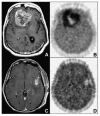Radiopharmaceuticals in preclinical and clinical development for monitoring of therapy with PET
- PMID: 19380404
- PMCID: PMC2963172
- DOI: 10.2967/jnumed.108.057281
Radiopharmaceuticals in preclinical and clinical development for monitoring of therapy with PET
Abstract
This review article discusses PET agents, other than (18)F-FDG, with the potential to monitor the response to therapy before, during, or after therapeutic intervention. This review deals primarily with non-(18)F-FDG PET tracers that are in the final stages of preclinical development or in the early stages of clinical application for monitoring the therapeutic response. Four sections related to the nature of the tracers are included: radiotracers of DNA synthesis, such as the 2 most promising agents, the thymidine analogs 3'-(18)F-fluoro-3'-deoxythymidine and (18)F-1-(2'-deoxy-2'-fluoro-beta-d-arabinofuranosyl)thymine; agents for PET imaging of hypoxia within tumors, such as (60/62/64)Cu-labeled diacetyl-bis(N(4)-methylthiosemicarbazone) and (18)F-fluoromisonidazole; amino acids for PET imaging, including the most popular such agent, l-[methyl-(11)C]methionine; and agents for the imaging of tumor expression of androgen and estrogen receptors, such as 16beta-(18)F-fluoro-5alpha-dihydrotestosterone and 16alpha-(18)F-fluoro-17beta-estradiol, respectively.
Figures










References
-
- Seidlin S, Marinelli L, Oshry E. Radioactive iodine therapy: effect on functioning metastases of adenocarcinoma of the thyroid. JAMA. 1946;132:838–847. - PubMed
-
- Dunn JT, Dunn AD. Update on intrathyroidal iodine metabolism. Thyroid. 2001;11:407–414. - PubMed
-
- Robbins RJ, Wan Q, Grewal RK, et al. Real-time prognosis for metastatic thyroid carcinoma based on 2-[18F]fluoro-2-deoxy-d-glucose-positron emission tomography scanning. J Clin Endocrinol Metab. 2006;91:498–505. - PubMed
-
- Hadj-Djilani NL, Lebtahi NE, Delaloye AB, Laurini R, Beck D. Diagnosis and follow-up of neuroblastoma by means of iodine-123 metaiodobenzylguanidine scintigraphy and bone scan, and the influence of histology. Eur J Nucl Med. 1995;22:322–329. - PubMed
-
- Lastoria S, Maurea S, Caraco C, et al. Iodine-131 metaiodobenzylguanidine scintigraphy for localization of lesions in children with neuroblastoma: comparison with computed tomography and ultrasonography. Eur J Nucl Med. 1993;20:1161–1167. - PubMed
Publication types
MeSH terms
Substances
Grants and funding
LinkOut - more resources
Full Text Sources
Miscellaneous
